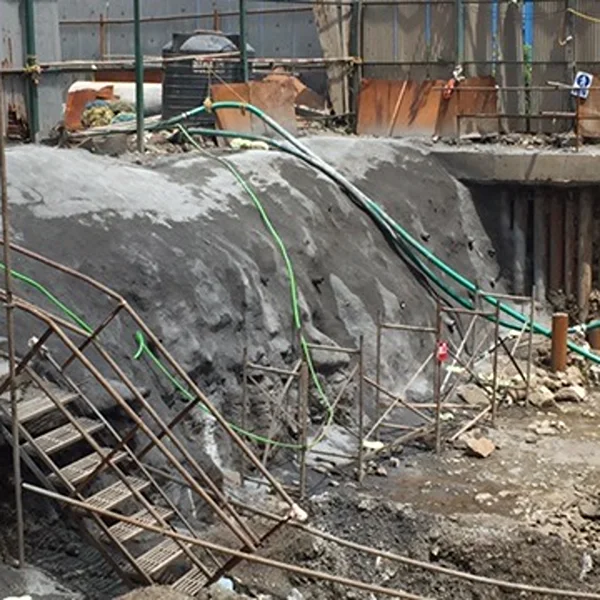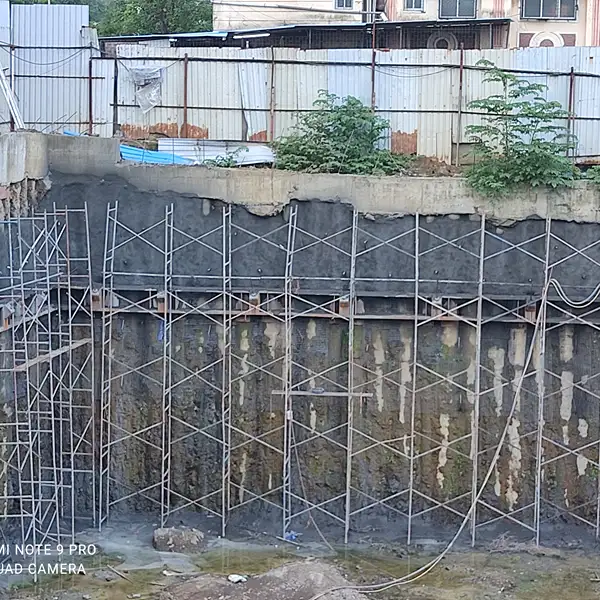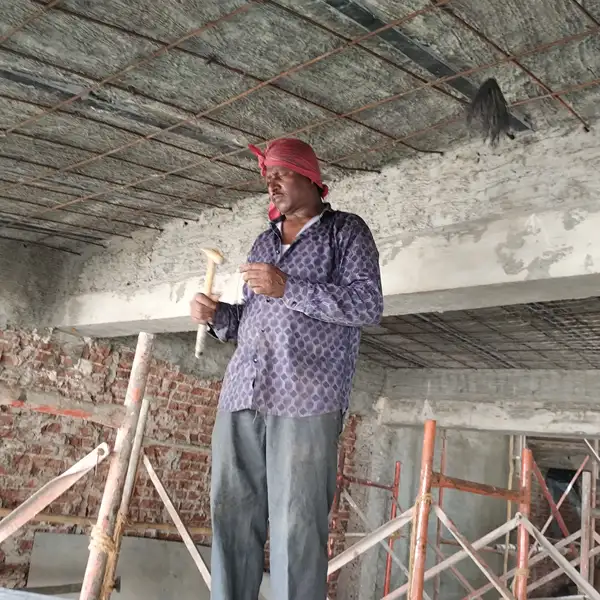Guniting & Shotcreting Services in Mumbai
When it comes to construction, the strength beneath the surface matters just as much as what’s above. We at ME Engineers, we specialize in Guniting and Shotcreting—two powerful techniques that help build safer, more durable structures, especially in areas with weak soil or steep slopes.
Whether it’s slope protection, soil stabilization, retaining walls, tunnels, or pile foundations, our expert team delivers precision-based, cost-effective solutions. Backed by years of on-site experience and industry-leading equipment, we offer top-grade gunite shotcrete and shotcrete concrete services tailored to your project.
Soil Stabilization

Soil Stabilization in Mumbai is a critical process that enhances soil strength, stability, and load-bearing capacity for construction projects. This technique involves physical, chemical, and mechanical methods to improve soil properties, ensuring safe and durable infrastructure development. As Top Soil Stabilization Contractors in Mumbai, we offer comprehensive Soil Stabilization Services tailored to meet diverse project requirements.
Our soil stabilization solutions include advanced techniques such as lime stabilization, cement treatment, and geosynthetics. These methods effectively reduce soil permeability, control erosion, and enhance structural performance. Whether for road construction, industrial foundations, or residential projects, our services ensure a solid, long-lasting base for your structures. Our expert team evaluates soil conditions meticulously, providing customized solutions that optimize construction efficiency and safety.
By choosing our Soil Stabilization Services, clients benefit from reduced maintenance costs and enhanced project longevity. We prioritize quality, safety, and sustainability, delivering projects on time and within budget. With a proven track record in Soil Stabilization in Mumbai, we are committed to transforming unstable ground into a robust foundation, setting new standards in soil engineering. Trust us for reliable and effective soil stabilization that ensures your construction projects stand strong against environmental challenges.
Slope Protection
Slope Protection in Mumbai is vital to prevent soil erosion, landslides, and surface runoff, particularly in urban areas with unstable slopes. Our Soil Protection Work includes advanced engineering and bioengineering techniques that ensure the safety and stability of your surroundings. As Top Soil Protection Contractors in Mumbai, we deliver tailored solutions for residential, commercial, and infrastructure projects.
Our slope protection services employ methods like retaining walls, soil nailing, rock bolting, and geotextile installations. Additionally, we incorporate eco-friendly approaches using vegetation to reinforce soil stability. These innovative techniques provide long-term slope protection while minimizing environmental impact. Our skilled team conducts detailed site assessments and implements effective strategies to mitigate risks associated with unstable slopes.
Choosing our Soil Protection Work ensures that your project is safeguarded from natural hazards. We focus on delivering durable solutions that not only enhance structural safety but also maintain the aesthetic and ecological balance of the area. Our reputation as leading Slope Protection Contractors in Mumbai is built on quality service, timely delivery, and a strong commitment to safety standards. Trust us to provide reliable and cost-effective slope protection services for your next project.

Shore Pile Guniting

A pile foundation is essential when constructing on unstable or weak ground, offering robust support by transferring structural loads to stable soil or rock layers. We specialize in pile foundation work in Mumbai, providing expert solutions for residential, commercial, and industrial projects. Our construction of pile foundation services ensure maximum safety and stability, even in challenging soil conditions.
Our team employs various piling techniques, including driven piles, bored piles, and micro piles, tailored to each project’s specific needs. The pile footing process involves deep drilling and secure installation, enhancing the load-bearing capacity of the foundation. Our advanced equipment and experienced professionals ensure precision and efficiency at every stage of construction.
As trusted experts in pile foundation work in Mumbai, we prioritize safety, compliance with engineering standards, and timely project completion. Our piling solutions are designed to reduce settlement issues, improve structural stability, and support large-scale developments. Whether for high-rise buildings, bridges, or industrial complexes, our construction of pile foundation services provide a solid and reliable foundation. Choose us for innovative, durable, and cost-effective piling solutions that set new benchmarks in construction excellence.
Rock Excavation
Our Rock Excavation Services in Mumbai offer efficient and safe solutions for removing hard and compacted materials, essential for construction, road development, and tunneling projects. As Top Rock Excavation Contractors in Mumbai, we combine advanced techniques and heavy-duty equipment to handle even the most challenging Rock Excavation Works.
We specialize in methods such as drilling, blasting, and mechanical breaking to manage excavation in rocky terrains. Our team ensures minimal disruption to surrounding areas while adhering to strict safety standards. With expertise in bulk excavation, trenching, and site preparation, we deliver projects on time and within budget. Our tailored Rock Excavation Works meet the specific needs of residential, commercial, and infrastructure projects, optimizing site readiness for construction.
By choosing our Rock Excavation Services in Mumbai, you gain a partner committed to quality, safety, and efficiency. We conduct thorough site assessments, plan strategically, and execute operations with precision. Our reputation as leading Rock Excavation Contractors in Mumbai is built on delivering exceptional results, even in the toughest conditions. Trust us for professional rock excavation services that lay a strong foundation for your construction projects.

RCC (Reinforced Cement Concrete)
Our Reinforced concrete services provide robust and durable construction solutions for various structures. Specializing in Reinforced concrete construction, we offer high-quality RCC Work in Mumbai, delivering exceptional strength and longevity to residential, commercial, and industrial projects.
By combining concrete with steel reinforcement, our RCC solutions address concrete’s natural limitations in tension and ductility. This blend ensures enhanced resistance to environmental stress, load-bearing efficiency, and structural stability. Our team of experts follows stringent engineering standards, using premium materials and advanced techniques to achieve top-tier construction outcomes.
Whether constructing foundations, beams, columns, or complex architectural elements, our RCC Work in Mumbai stands out for precision, safety, and durability. We manage projects from planning through to execution, maintaining transparency, meeting deadlines, and adhering to budget constraints. Choose our Reinforced concrete construction services to build lasting structures that reflect quality craftsmanship and engineering excellence.

Building External

Our External Building Maintenance in Mumbai services provide comprehensive care for your property’s exterior, enhancing both its aesthetic appeal and structural integrity. We offer a wide range of External Building Maintenance Services, including cleaning, waterproofing, façade restoration, and repairing damaged components like windows, doors, and cladding.
Regular external maintenance is crucial for preserving property value, ensuring safety, and reducing long-term repair costs. Our expert team uses modern techniques and eco-friendly materials to deliver effective and sustainable solutions. We cater to residential, commercial, and industrial buildings, ensuring they remain in top condition throughout the year.
As specialists in External Building Maintenance in Mumbai, we focus on quality, durability, and safety. Our maintenance programs are designed to address weather-related wear and tear, structural damages, and aesthetic deterioration. From routine cleaning to complex restoration projects, we handle every task with professionalism and efficiency. Trust our experienced team to protect and enhance your building’s exterior with our reliable and high-quality maintenance services.
What is Guniting / Shotcreting?
Guniting and Shotcreting are modern techniques used to spray concrete or mortar onto surfaces using high pressure. This method is especially useful for strengthening structures, protecting slopes, and repairing damaged concrete in bridges, tunnels, retaining walls, dams, tanks, and basements.
Though the terms are often used interchangeably, there’s a small difference between the two:
- Guniting refers to the dry-mix process, where dry cement and sand are mixed and pushed through a hose. Water is added only at the nozzle before spraying.
- Shotcreting usually refers to the wet-mix process, where water is mixed with cement and sand before it’s sprayed.
Guniting and Shotcreting involve spraying concrete (wet or dry) at high pressure onto a surface.
- Shotcrete – Wet-mix concrete
- Gunite – Dry-mix concrete
They’re used for:
- Retaining walls
- Slope protection
- Shore pile guniting
- Tunnels
- Basement & trench excavation support
Both methods provide super-strong support, especially in challenging landscapes or loose soil zones.
Why Clients Trust ME Engineers
“We had a tight project deadline and unstable slope near the foundation. ME Engineers handled the shotcreting and soil stabilization with speed and professionalism. Saved us from what could have been a big delay!”
“Their gunite work on our retaining walls has held up perfectly through two monsoons. Extremely impressed with their quality and service!”
Our Core Services with Guniting / Shotcreting
We at ME Engineers specialize in delivering reliable, high-performance Guniting and Shotcreting solutions tailored for infrastructure, tunneling, slope stabilization, and structural rehabilitation projects. With years of experience, advanced equipment, and a skilled team, we ensure long-lasting, cost-effective protection and repair for all types of concrete surfaces.
Here’s a look at our core services under Guniting / Shotcreting:
Soil Stabilization
Unstable soil? We’ve got you covered, as top Soil Stabilization Contractors in Mumbai, we use advanced methods like:
- Lime & cement treatment
- Chemical grouting
- Bentonite grouting
- Geosynthetics
Slope Protection
Protect your construction site from erosion, landslides, and water runoff with:
- Shotcrete slopes
- Soil nailing & rock bolting
- Eco-friendly vegetation support
See Our Soil & Rock Anchoring Services
Excavation & Foundation Support
From topsoil excavation to rock and muck excavation, we prep your site the right way. We also provide pile foundation services that go deep to anchor your structure with confidence.
Additional Support Services
Grouting Solutions We offer:
- Cement grouting to fill cracks and voids
- Chemical grouting for water control
- Bentonite grouting to stabilize soil and block water
RCC (Reinforced Cement Concrete) Work
- We deliver top-quality RCC construction with long-lasting durability, perfect for foundations, columns, slabs, and more.
External Building Maintenance
- From façade repairs to waterproofing, our building maintenance team ensures your property looks great and stays protected.
Guniting Hopper Rental
Need tools for the job?
We offer Guniting Hopper machines on rent—essential for dry-mix concrete spraying. Ideal for contractors and builders looking to apply gunite with precision.
Why Choose ME Engineers?
- Experienced Guniting & Shotcreting Contractors in Mumbai
- High-quality, durable finishes
- Reliable soil and slope stabilization techniques
- Modern equipment & trained technicians
- On-time, within-budget project delivery
What are Benefits of Guniting & Shotcreting?
- Increases soil strength and reduces erosion
- Prevents landslides and slope failures
- Strengthens pile foundations and shore piles
- Protects retaining structures and basements
- Enhances the life of concrete in tough environments
Get in Touch
Ready to build stronger, smarter, and safer? Whether it’s a hillside project, a deep excavation, or a building requiring reinforcement, we’ve got the tools and expertise to make it happen.
Contact ME Engineers today for professional shotcreting and guniting solutions in Mumbai.